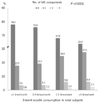Abstract
BACKGROUND/OBJECTIVES
SUBJECTS/METHODS
RESULTS
Figures and Tables
 | Fig. 1Number of metabolic syndrome components according to the frequency of instant noodle consumption in all subjects.Reference values for MS components according to the Adult Treatment Panel III of the National Cholesterol Education Program (abdominal obesity: males ≥ 90 cm WC, females ≥ 85 cm; elevated blood pressure: SBP ≥ 130 mmHg or DBP ≥ 85 mmHg, hyperglycemia: FBS ≥ 100 mg/dL, hypertriglycemia: TG ≥ 150 mg/dL, low HDL cholesterol: males < 40 mg/dL, females < 50 mg/dL). MS, metabolic syndrome; WC, waist circumference; SBP, systolic blood pressure; DBP, diastolic blood pressure; FBS, fasting blood glucose; TG, triglycerides. P-value by χ2 test.
|
Table 1
Characteristics of study participants according to the frequency of instant noodle consumption1)

Table 2
Other food consumption of study participants according to the frequency of instant noodle consumption1)

Food groups were fruits, vegetables (except Kimchi), milk and dairy products (yogurt/cheese, etc.), high-fat fish (mackerel/sardines/tuna/herring/salmon, etc.), high-fat and processed meats (fresh bacon/beefribs/charcoal grilled meat/tripe/ham/sausage/bacon), instant noodle/cup noodle, sweets and confectionery (cakes/cookie/pies/candies/chocolates), and carbonated beverages (coke/sprite/soft drinks/fruit-flavored drinks except 100% fruit juice).
1)Data are presented as N(%).
2)P-value by χ2 test.
Table 3
Metabolic parameters according to the frequency of instant noodle consumption1)

WC, waist circumference; SBP, systolic blood pressure; DBP, diastolic blood pressure; FBS, fasting blood glucose; TG, triglycerides; MS, metabolic syndrome.
1)Data are presented as mean ± SD.
2)Adjusted P-value from the general linear model after controlling for age, BMI, gender, family income (< 2000 US $/mo, 2000–4000 US $/mo, > 4000 US $/mo), alcohol consumption (non-drinker, moderate drinker, heavy drinker), smoking behavior (non-smoker, ex-smoker, current smoker), physical activity (low, moderate, high), and consumption frequency of fruits, vegetables, milk and dairy products, high-fat fish, high-fat and processed meats, sweets and confectionery, carbonated beverages (≤ 1 time/month, 2–3 times/month, 1–2 times/week, ≥ 3 times/week).
Table 4
Multivariate odds ratios (ORs) and 95% confidence intervals (CIs) for cardiometabolic risk factors according to the frequency of instant noodle consumption1)

1)Determined by multivariate logistic regression analysis after controlling for age, BMI, gender, family income (< 2000 US $/mo, 2000-4000 US $/mo, > 4000 US $/mo), alcohol consumption (non-drinker, moderate drinker, heavy drinker), smoking behavior (non-smoker, ex-smoker, current smoker), physical activity (low, moderate, high), and consumption frequency of fruits, vegetables, milk and dairy products, high-fat fish, high-fat and processed meats, sweets and confectionery, carbonated beverages (≤ 1 time/month, 2–3 times/month, 1–2 times/week, ≥ 3 times/week).
Reference values according to the Adult Treatment Panel III of the National Cholesterol Education Program (abdominal obesity: males ≥ 90 cm, females ≥ 85 cm; elevated blood pressure: SBP ≥ 130 mmHg or DBP ≥ 85 mmHg, hyperglycemia: FBS ≥ 100 mg/dL; hypertriglycemia: TG ≥ 150 mg/dL, low HDL cholesterol: males < 40 mg/dL, females < 50 mg/dL, high LDL cholesterol: ≥ 130 mg/dL).




 PDF
PDF ePub
ePub Citation
Citation Print
Print


 XML Download
XML Download